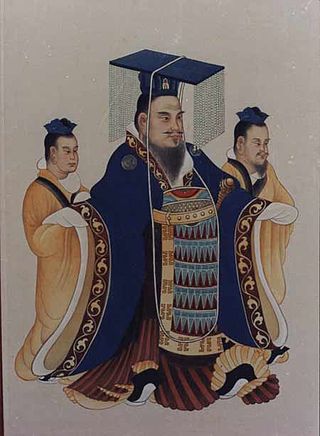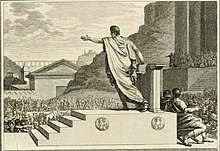
The 2nd century BC started the first day of 200 BC and ended the last day of 101 BC. It is considered part of the Classical era, although depending on the region being studied, other terms may be more suitable. It is also considered to be the end of the Axial Age. In the context of the Eastern Mediterranean, it is the mid-point of the Hellenistic period.
Year 106 BC was a year of the pre-Julian Roman calendar. At the time it was known as the Year of the Consulship of Caepio and Serranus and the Fifth Year of Yuanfeng. The denomination 106 BC for this year has been used since the early medieval period, when the Anno Domini calendar era became the prevalent method in Europe for naming years.

Year 100 BC was a year of the pre-Julian Roman calendar. At the time it was known as the Year of the Consulship of Marius and Flaccus and the First Year of Tianhan. The denomination 100 BC for this year has been used since the early medieval period, when the Anno Domini calendar era became the prevalent method in Europe for naming years.

This article concerns the period 109 BC – 100 BC.
This article concerns the period 129 BC – 120 BC.
This article concerns the period 139 BC – 130 BC.
Year 90 BC was a year of the pre-Julian Roman calendar. At the time it was known as the Year of the Consulship of Caesar and Lupus and the Third Year of Zhenghe. The denomination 90 BC for this year has been used since the early medieval period, when the Anno Domini calendar era became the prevalent method in Europe for naming years.
Year 91 BC was a year of the pre-Julian Roman calendar. At the time it was known as the Year of the Consulship of Philippus and Caesar and the Second Year of Zhenghe. The denomination 91 BC for this year has been used since the early medieval period, when the Anno Domini calendar era became the prevalent method in Europe for naming years.

Year 133 BC was a year of the pre-Julian Roman calendar. At the time it was known as the Year of the Consulship of Scaevola and Frugi and the Second Year of Yuanguang. The denomination 133 BC for this year has been used since the early medieval period, when the Anno Domini calendar era became the prevalent method in Europe for naming years.
Year 128 BC was a year of the pre-Julian Roman calendar. At the time it was known as the Year of the Consulship of Octavius and Rufus and the First Year of Yuanshuo. The denomination 128 BC for this year has been used since the early medieval period when the Anno Domini calendar era became the prevalent method in Europe for naming years.
Year 123 BC was a year of the pre-Julian Roman calendar. At the time it was known as the Year of the Consulship of Balearicus and Flamininus and the Sixth Year of Yuanshuo. The denomination 123 BC for this year has been used since the early medieval period, when the Anno Domini calendar era became the prevalent method in Europe for naming years.
Year 184 BC was a year of the pre-Julian Roman calendar. At the time it was known as the Year of the Consulship of Pulcher and Licinus. The denomination 184 BC for this year has been used since the early medieval period, when the Anno Domini calendar era became the prevalent method in Europe for naming years.
Year 121 BC was a year of the pre-Julian Roman calendar. At the time it was known as the Year of the Consulship of Opimius and Allobrogicus and the Second Year of Yuanshou. The denomination 121 BC for this year has been used since the early medieval period, when the Anno Domini calendar era became the prevalent method in Europe for naming years.
Year 154 BC was a year of the pre-Julian Roman calendar. At the time it was known as the Year of the Consulship of Opimius and Albinus/Glabrio. The denomination 154 BC for this year has been used since the early medieval period, when the Anno Domini calendar era became the prevalent method in Europe for naming years.
Year 177 BC was a year of the pre-Julian Roman calendar. At the time it was known as the Year of the Consulship of Pulcher and Gracchus. The denomination 177 BC for this year has been used since the early medieval period, when the Anno Domini calendar era became the prevalent method in Europe for naming years.
Year 179 BC was a year of the pre-Julian Roman calendar. At the time it was known as the Year of the Consulship of Flaccus and Fulvianus. The denomination 179 BC for this year has been used since the early medieval period, when the Anno Domini calendar era became the prevalent method in Europe for naming years.

Emperor Jing of Han, born Liu Qi (劉啟), was the sixth emperor of the Han dynasty from 157 to 141 BC. His reign saw the limiting of the power of the feudal kings and princes which resulted in the Rebellion of the Seven States in 154 BC. Emperor Jing managed to crush the revolt and princes were thereafter denied rights to appoint ministers for their fiefs. This move helped to consolidate central power which paved the way for the long reign of his son Emperor Wu of Han.

Emperor Wu of Han, born Liu Che (劉徹) and courtesy name Tong (通), was the seventh emperor of the Han dynasty from 141 to 87 BC. His reign lasted 54 years – a record not broken until the reign of the Kangxi Emperor more than 1,800 years later — and remains the record for ethnic Han emperors. His reign resulted in a vast expansion of geopolitical influence for the Chinese civilization, and the development of a strong centralized state via governmental policies, economical reorganization and promotion of a hybrid Legalist–Confucian doctrine. In the field of historical social and cultural studies, Emperor Wu is known for his religious innovations and patronage of the poetic and musical arts, including development of the Imperial Music Bureau into a prestigious entity. It was also during his reign that cultural contact with western Eurasia was greatly increased, directly and indirectly.
Liu Pi was a nephew of Emperor Gao of Han, son of Liu Xi, Prince of Dai, and appointed Prince of Wu by Emperor Gao. During the reign of Emperor Jing, he initiated the Rebellion of the Seven States to resist the Emperor's centralizing policies, during which he was defeated and killed.
Liu Jiao was a younger brother of Emperor Gaozu of Han and a famous scholar.





